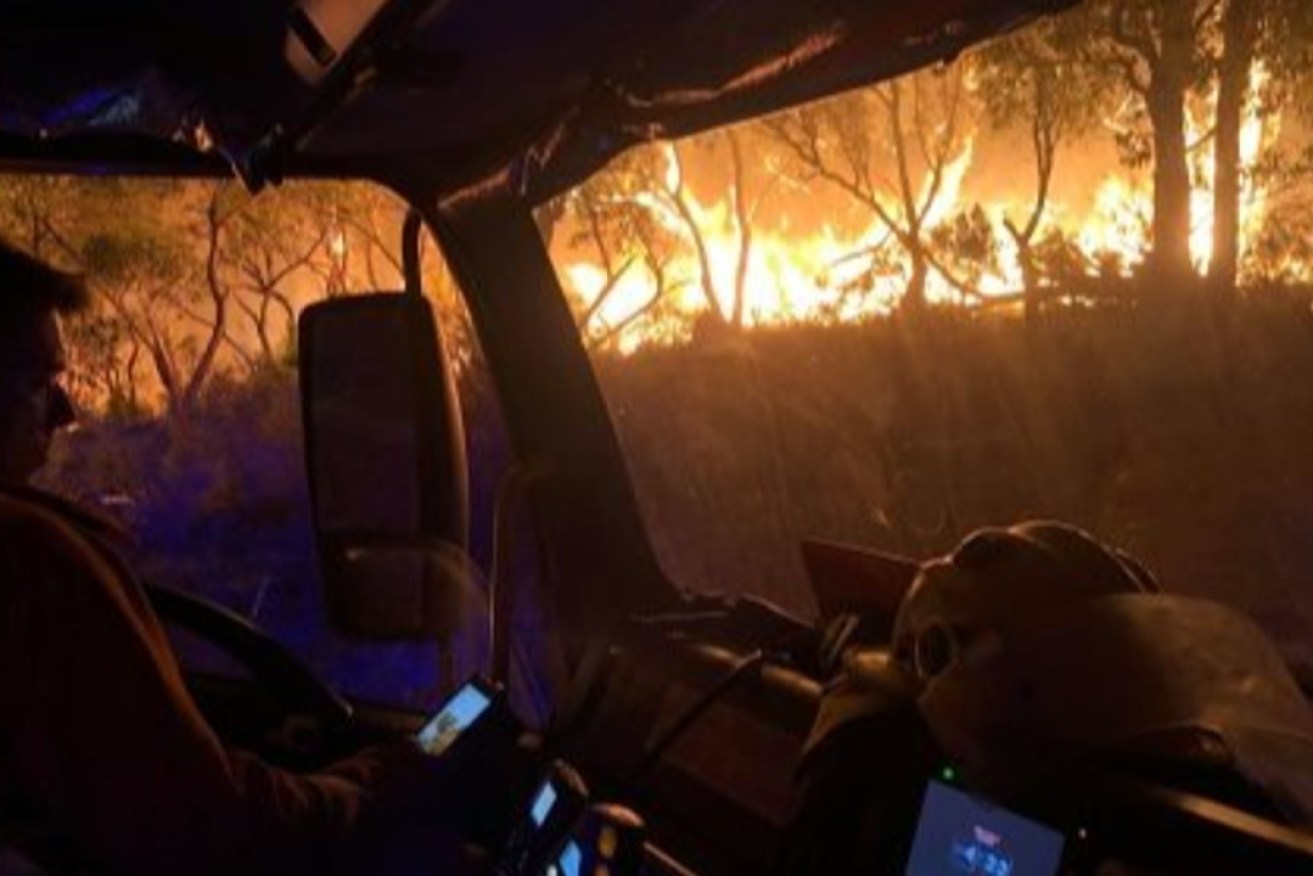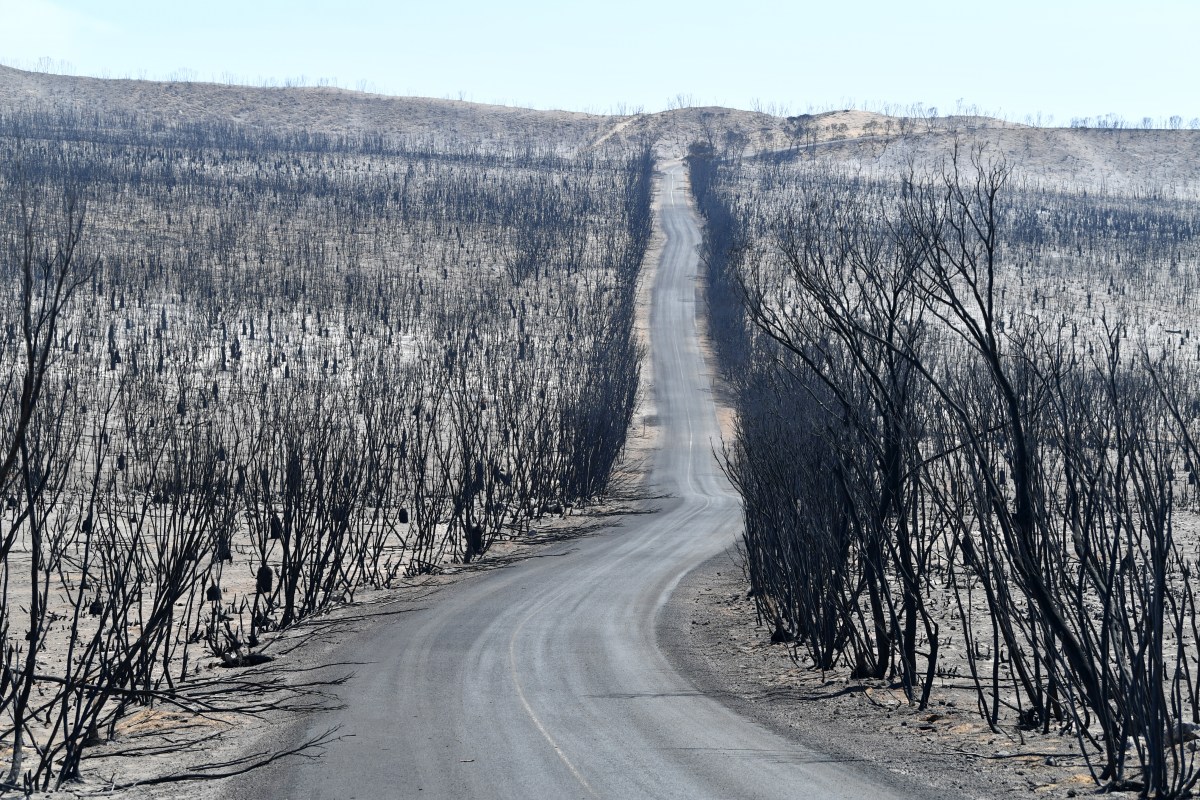Flames, fear and forgetting: An anniversary to dread
Amid warnings of a dangerous bushfire season, Alan Atkinson looks back on living through the Ash Wednesday disaster 40 years ago and asks: have we become complacent, and could it happen again?

Flames near Mount Bold after a 2021 Adelaide Hills bushfire. Photo by CFS volunteer Andrew Noble.
We had never seen a day dawn so brutally threatening.
A dark forbidding northern sky morphing from blood red to brown to black-grey, changing every minute as strong winds lifted dust from distant plains and hurled it towards us. Early on, our trees stood still and quiet before the storm to come. But in the calm you could almost hear the warning: Be afraid.
And yet: nothing prepared us for what was to come. We knew it would be a bad day, but what could I do? No sprinklers then. Just garden hoses. And anyway, the CFS would come. I left my Bridgewater cottage and terraced hillside garden and drove to work at the newspaper in the city. I had friends staying at the house, so figured it would be okay. And they’d look after the chickens.
Ignorance? Bravado? Only in hindsight. We’d had fires before. A big one just two years earlier. Started in a rubbish dump. I felt informed. I knew that 1982 had seen the culmination of what they called El Nino-induced droughts across much of eastern Australia, and rainfall that summer was dramatically lower than previous years. There had already been big fires for months in Victoria. In South Australia too, the land – on the flat and in the hills – was parched and once again ready to burn.
It was February 16, 1983, and at the newspaper we worked and waited – increasingly nervously. We knew that morning temperatures in Melbourne and Adelaide were already in the forties, with winds gusting over 100km/h. What we didn’t know was that the fierce northerlies would change to gale-force south-westerlies, creating unstoppable fire fronts moving at breakneck speed. Winds of such force, it seems, no-one was expecting.
The call came sometime around lunchtime. My friend in Bridgwater, sounding panicked, said you’d better come, the garden’s on fire. What about the chooks? I said, without thinking. Gotta go, she shouted, I can hear crackling.
Arriving at the crest I could see my tiered garden was already mostly black but down at the front the shed, stacked with wood, was well ablaze and now burning the pines beside it
My beloved dark green Beetle was close to exploding by the top of the freeway where towering black clouds were already cresting white. I hurtled through swirling smoke, past fire trucks and police, cutting through a supermarket car park to avoid roadblocks.
My cottage was set back from the main road at the foot of a hill, screened at the front by six tall pine trees. Beneath them stood a large shed which served as garage and woodstore. A rough stone path led through the terraced gardens to the cottage, behind which wild acreage rose up to a fence beside the railway line. That’s where the chooks lived.
Arriving at the crest I could see my tiered garden was already mostly black but down at the front the shed, stacked with wood, was well ablaze and now burning the pines beside it. Smoke cut visibility but I guessed other houses were probably burning nearby. I left my car away from the house and ran, jumping past the small flames on either side of my stone steps. Agapanthus had already shrivelled, fruit trees were turning brown – but at least the singed cherry-plums had saved the house.
I felt lucky. The blaze had raced through, killing only the low plants, the grass and the chooks. I’d survived the worst, I thought. Little did I know that stronger winds would come again and take out my neighbour John’s house. For now my only option was to stand on my own tin roof and put out any embers in the gutters. For hours, holding trickling hoses, we stood guard, extinguishing small flare-ups. A neighbour to my right, in a solid brick house, was damping down as well. Like me, he still had a home.
My side wall formed part of the boundary to the left adjoining a little garden on which stood John’s tiny fibro cottage. John, a rough diamond with a chequered past and a love of cats, was away. I knew he’d recently lost a cat and had bought a new kitten. I hoped he’d taken it with him. Beyond John’s house was an old two-storey brick home inhabited by an elderly lady. Her garden, like John’s and mine, was black. One of my friends battled through smoke to check on her, but then fire trucks rushed up. With much yelling and hauling of hoses, the crews went to the old lady’s house. I saw them get her out. The winds were up again, roaring through. There was no saving her large house, which soon exploded into flame. Flames were now licking at John’s little cottage below me. Anyone there? a fireman shouted up to me. I shook my head. Let it go, he yelled to his crew.
So as I stood, keeping my own walls wet, I watched John’s house disintegrate, torn apart by flames and wind gusts. It was hot but bearable. Friends brought wet towels. I was just thankful John was not home.
John, a tough little nugget, had become a good friend. He’d had a terrible life, alcoholic and wracked with violence and injury. He’d worked on the railroads, had finally got off the grog, and now a disability pensioner, lived alone with his cats and vegetables. We had long talks, and once he showed me the rifle he promised he would use if a long-hated brother ever came to bother him. Somehow I managed to persuade him to let me keep the rifle in a safe place in my cottage.
I was still on my roof when John came walking up to the smoking ruins of his cottage. Aghast, he began to lift a few sheets of blackened fibro. I got down and went over. Where is she? he whispered. Where is she? He had only one thought. His kitten. He lifted another sheet. Tears streaked his weather-beaten, lined face. Don’t John, don’t, I heard myself pleading. No, I have to find her, he said. I felt sick as I watched him search.
Then he stood up, quite still. Listen! he said. I’d heard nothing through the swirling wind. I said so. Listen, he insisted. Then he walked quickly over to the back of my house and the gutter below the tin roof where I had been standing. I followed, still fearing the worst. There, in a gap between the gutter and the roof, were two tiny terrified eyes. The mewling kitten’s fur was singed, its paws black. Gently John lifted it from its hiding place. He opened his jacket and put the bundle inside. It’s ok, he said. The rest can go. I don’t need anything else. Utterly relieved, I watched him walk back down to his car. He’d saved his friend. In that moment, nothing else mattered.
There was no saving her large house, which soon exploded into flame.
Elsewhere, the toll was more tragic. In South Australia 28 people died that day, 47 in Victoria. Thousands lost their homes. Thousands of hectares of land and forests were burned. Livestock and wildlife losses were massive. Faulty powerlines were partly to blame. Radio communication in many areas was non-existent. Many so-called reforms were instigated after Ash Wednesday 1983. People were urged not to build homes with stringy-barks as verandah ornaments. New radio networks were set up. Trees near powerlines were lopped.
As the land regrew, and the months passed, people forgot. They still thought the fire services would save them. Government approved new housing estates in the hills with little thought of escape routes. People still built homes next to gum trees. It couldn’t happen again, many people thought.
But of course it did. In 2003, Canberra was hit. In 2009 173 people died in Victoria. Ten years later, in 2019, fires across the country devastated huge areas, with 34 people dead, billions of animals killed, and almost 3000 homes lost. One of the places badly hit was South Australia’s Kangaroo Island.

The bushfires of summer 2019/20 devastated large areas of Kangaroo Island. Photo: AAP/David Mariuz
In her devastating critique called Fire, islander Margi Prideaux – who lost her home – holds out little hope that collectively we will change the way we think, in particular about climate change.
At least these days – unlike in 1983 – we are now told endlessly that the fire services will not be there to save us and that residents must plan to leave early. But with the 41st anniversary of Ash Wednesday less than two months away, is it still the case that many of us are still thinking: It couldn’t happen again, could it?
Alan Atkinson is an Adelaide journalist and author




